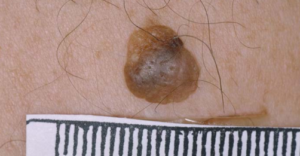That one particular mole, or maybe several of them, are generating weird feelings. Could this mean melanoma?
This isn’t about itching. It’s about weird sensations that seem to be coming from a mole that’s gotten your attention lately.
If you’ve already been diagnosed with melanoma, you may be at risk for noticing strange feelings from other moles.
“In general, melanoma does not produce any symptoms in the skin such as pain or itching, although rarely these symptoms may be noted,” says Kara Shah, MD, an adult and pediatric dermatologist and founder of Kenwood Dermatology in Cincinnati, OH.
Even though it’s an uncommon sign of melanoma, an itchy or painful mole should never be ignored, because melanoma CAN cause these symptoms.
“While any mole that is painful, itching or bleeding should be evaluated by a dermatologist, if the mole itself appears normal with none of the worrisome features for melanoma, it does not need to be removed,” says Kara Shah, MD, an adult and pediatric dermatologist and founder of Kenwood Dermatology in Cincinnati, OH.
What’s happening when someone notices odd or weird sensations coming from a mole?
As mentioned, a previous diagnosis of melanoma can put a person at risk for these perceptions.
Dr. Shah explains, “Receiving a diagnosis of melanoma can be a frightening experience, and this may result in increased anxiety and concern for the development of additional cutaneous melanomas.”
The anxiety can play tricks on the patient’s mind. There was the case of a man who’d been diagnosed with a single melanoma.
Soon after, he became convinced that about 20 additional moles were generating “weird feelings.”
Suspecting that they were cancerous, he requested removal of all of them. Every one came back benign.
“However, as the majority of moles never develop into melanoma, removal of otherwise benign-appearing moles is not recommended,” says Dr. Shah.
Anxiety About Getting Another Melanoma
Dr. Shah says, “Strategies that can be helpful in reducing anxiety surrounding melanoma in someone with a previous diagnosis include periodic skin examinations by a dermatologist and use of mole mapping and digital dermascopy to document and monitor existing moles.”
Worrisome Features of a Mole
• Increase in size
• Change in shape or texture
• Change in color or darkening
• Appearance of tiny bumps on the surface
• Any other change, such as a once-smooth border is now jagged.
• Appearance of tiny “satellite” moles near it
• Unexplained bleeding
• Oozing or crusting
• Center of the mole is disappearing
• A new bump that looks like a pimple but won’t go away
• A new, rapidly growing nodule (bump)
Any one of these signs does not automatically mean melanoma.
For example, what you thought was a mole all along might actually be a benign skin growth called a seborrheic keratosis. But have your dermatologist make this diagnosis; don’t assume.

Seborrheic keratosis
Furthermore, melanoma simply does not cause “weird feelings” or strange sensations to come from a mole.
Serial digital dermoscopy is an excellent way to track your moles over time.
Dr. Shah is triple board certified: general dermatology, pediatric dermatology and general pediatrics. Her special interests include melanocytic nevi (moles), melanoma, psoriasis, acne, atopic dermatitis/eczema, hair and nail disorders, birthmarks and genetic skin diseases.
 Lorra Garrick is a former personal trainer certified by the American Council on Exercise. At Bally Total Fitness she trained clients of all ages for fat loss, muscle building, fitness and improved health.
Lorra Garrick is a former personal trainer certified by the American Council on Exercise. At Bally Total Fitness she trained clients of all ages for fat loss, muscle building, fitness and improved health.
.











































